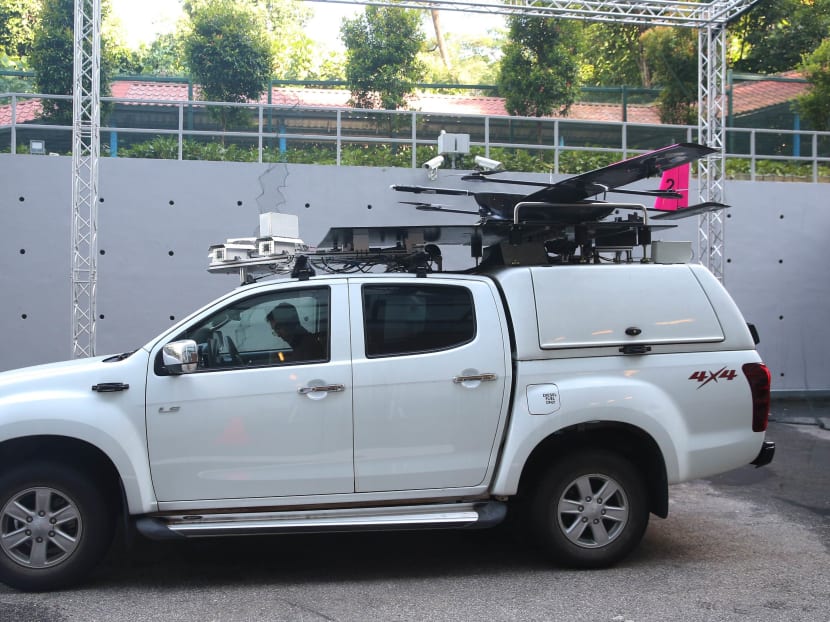In the making: Drones that fly without GPS to boost SAF capabilities
SINGAPORE — Operating as a team, an autonomous vehicle with an unmanned aerial vehicle (UAV) flying overhead as surveillance could go deep into complex and unfamiliar terrains such as dense forests to deliver supplies to the battlefield.

DSO's Unmanned Ground Vehicle (UGV) with the Unmanned Aerial Vehicle (UAV) mounted on it. Photo: Wee Teck Hian.
SINGAPORE — Operating as a team, an autonomous vehicle with an unmanned aerial vehicle (UAV) flying overhead as surveillance could go deep into complex and unfamiliar terrains such as dense forests to deliver supplies to the battlefield.
Such air-to-ground “teaming”, where the UAV can take off from and land vertically on the unmanned ground vehicle, is a key project being developed by the Defence Ministry’s research-and-development arm — a capability that few militaries can boast of now.
The vehicles will also be able to navigate without the use of the Global Positioning System (GPS), a rarity among unmanned systems globally.
The V35 next-generation UAV is being worked on at the robotics laboratory in the sprawling new DSO Complex, which was opened officially by Defence Minister Ng Eng Hen on Friday (April 21).
It can be mounted atop the unmanned ground vehicle, allowing it to travel “more than three times” further, since it can be transported out into the field to be launched.
Mr Hikaru Fujishima, a programme manager in DSO’s information division, said: “The aircraft will now have an extended range compared with launching (it) right from the beginning (from a runway).”
Typically, UAVs of similar size would need a 500m-long runway to take off. This next-generation UAV eliminates the need for one.
Mr Jonathan Yong, a senior research engineer in DSO’s guided systems division, said: “Not only can (the UAV) be launched from a vehicle, it can be launched from a small area of clearing in the forest ... so it makes it a lot more attractive for our forces.”
The UAV can clock “more than 10 hours” of continuous flight with the vertical take-off and landing capabilities.
The new system also cuts the reliance on manpower, requiring just two persons to assemble and deploy. Otherwise, it is typically a six-man team, including UAV operators and ground crew, who have to roll the aircraft out to the runway, for example.
Both the aerial and ground vehicles navigate without GPS, by banking on navigation techniques such as light detection and ranging, the unmanned ground vehicle’s vision sensors, and the UAV’s satellite maps. This means they can navigate in both forests and urban environments, Mr Fujishima said.
A possible scenario may see both vehicles being sent into battlefield to deliver supplies, with the UAV scouting the surroundings so that they advance safely.
Speaking to the media after opening the new DSO Complex, Dr Ng said: “What our scientists and engineers do in this building is just as important as what the SAF (Singapore Armed Forces) does out there training.”
With a floor area of 69,000sqm, the complex on Science Park Drive houses more than 1,000 of DSO’s 1,900 employees across more than 200 offices and laboratories, including research engineers and scientists.
Dr Ng pointed out that the challenges facing the SAF would require more effective and intelligent use of technology, especially when there are manpower constraints.
The DSO is focusing on robotics, autonomous systems and artificial intelligence — if successful, these initiatives would help the SAF to meet the challenges it confronts, he added.
Dr Ng noted that the nature of security threats today, such as the presence of suicide-bombers and lone-wolf attacks, were unheard of more than a decade ago. The work of the employees in the DSO Complex “will determine whether we have the wherewithal to meet this threat”, he said.








